
Ancash is a department and region in western Peru. It is bordered by the departments of La Libertad on the north, Huánuco and Pasco on the east, Lima on the south, and the Pacific Ocean on the west. Its capital is the city of Huaraz, and its largest city and port is Chimbote. The name of the region originates from the Quechua word anqash, from anqas ('blue') or from anka ('eagle').
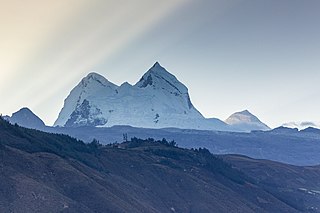
The Cordillera Blanca is a mountain range in Peru that is part of the larger Andes range and extends for 200 kilometres (124 mi) between 8°08' and 9°58'S and 77°00' and 77°52'W, in a northwesterly direction. It includes several peaks over 6,000 metres (19,690 ft) high and 722 individual glaciers. The highest mountain in Peru, Huascarán, at 6,768 metres (22,205 ft) high, is located there.

Huaraz, founded as San Sebastián de Huaraz, is a city in Peru. It is the capital of the Ancash Region and the seat of government of Huaraz Province. The urban area's population is distributed over the districts of Huaraz and Independencia. The city is located in the middle of the Callejon de Huaylas valley and on the right side of the Santa river. The city has an elevation of approximately 3050 meters above sea level. The built-up area covers 8 square kilometers and has a population of 120,000 inhabitants, making it the second largest city in the central Peruvian Andes after the city of Huancayo. It is the 22nd largest city in Peru. Huaraz is the seat of the province's Roman Catholic Bishop and the site of the cathedral.
The Santa Valley is an inter-andean valley in the Ancash Region in the north-central highlands of Peru. Due to its location between two mountain ranges, it is known as Callejón de Huaylas, the Alley of Huaylas, whereas "Huaylas" refers to the territorial division's name during the Viceroyalty of Peru.
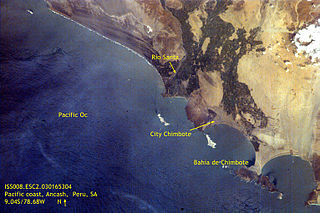
The Santa River is a river in the South American Andes mountain range in the Ancash Region of northwest central Peru.

The Huaraz Province is one of twenty provinces of the Ancash Region in Peru. It was created on August 5, 1857 during the presidency of Ramón Castilla. Geographically, the province is located over the Callejón de Huaylas and the western slopes of the Cordillera Negra.
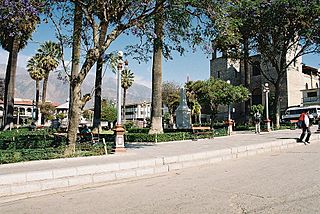
The Caraz District is one of 10 districts of the Huaylas Province in the Ancash Region of Peru. The capital of the district is Caraz. Its elevation is 2,285 m. In Caraz, the paved road comes from Pativilca.

The Mato District is one of 10 districts of the Huaylas Province in the Ancash Region of Peru. The capital of the district is the village of Villa Sucre.

Yuracmarca or Yuraq Marka is one of 10 districts of the Huaylas Province in the Ancash Region of Peru. The capital of the district is the village of Yuracmarca.

The Santa Cruz District is one of 10 districts of the Huaylas Province in the Ancash Region of Peru. The capital of the district is Huaripampa.
Cañón del Pato is on the Rio Santa at the north end of the Callejón de Huaylas in north-central Peru. The mostly rocky canyon walls are too steep and arid for cultivation, and in only a few places are the slopes of the imposingly rugged canyon suitable even for grazing domestic animals. The canyon was formed by the river where the north end of the Cordillera Negra range converges with the Cordillera Blanca mountain range. These two Andean ridges run generally parallel for nearly 140 km from south of the city of Huaraz northward to the Cañón; the Cordillera Blanca continues northward for another hundred kilometers or more. The Callejón de Huaylas is the valley between the two cordilleras averaging about 16 km in width but in places as much as 25 km in width.

Coñocranra is a mountain of Peru located in the Ancash Region, Santa Province. It is the highest mountain in the Cordillera Negra at.
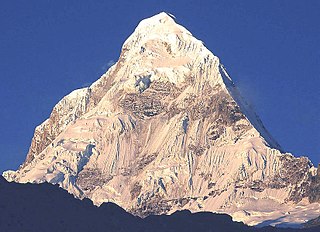
Santa Cruz, Pucaraju,Pukaraju or Pico de Huaylas is a mountain in the Cordillera Blanca in the Andes of Peru; within Santa Cruz District, Huaylas Province, Ancash. It has a height of 6,259 metres (20,535 ft), although other maps cite a height of 6,241 metres (20,476 ft).

Sentilo is a 5,100-metre-high (16,700 ft) mountain in the Cordillera Blanca in the Andes of Peru. It is located in Ancash Region, Huaylas Province, Santa Cruz District. Sentilo lies at the Punta Unión pass, the highest point of the Santa Cruz valley, south of the mountains Rinrijirca and Pucajirca, southwest of Taulliraju, and northeast of mountains Artesonraju and Parón.
Lake Ichiccocha or Lake Chica is a lake in the Cordillera Blanca in the Andes of Peru located in Ancash Region, Huaylas Province, Santa Cruz District. It lies within Santa Cruz Creek, between the mountains Pomabamba to the north and Caraz to the south, southwest of the larger lake Jatuncocha.
Jatuncocha is a lake in the Cordillera Blanca in the Andes of Peru located in the Ancash Region, Huaylas Province, Santa Cruz District. It is situated at a height of 3,886 m (12,749 ft) comprising an area of 0.486550 km2 (486,550 m2). Jatunccocha lies in the Santa Cruz gorge between the peaks of Quitaraju in the north and Caraz in the south, northeast of a smaller lake named Ichiccocha.

Santa Cruz, is a creek in Peru located in Santa Cruz District, Huaylas Province, Ancash. It is a right tributary of the Santa River.
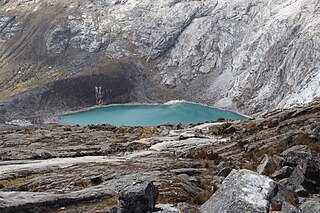
Taullicocha or Tawlliqucha is a lake in the Cordillera Blanca in the Andes of Peru located in the Ancash Region, Huaylas Province, Santa Cruz District. It is situated at a height of 4,426 m (14,521 ft) comprising an area of 0.133766 km2 (133,766 m2). Taullicocha lies southeast of Pucajirca and southwest of Taulliraju.

Quilcayhuanca, Quillcay,Quilcay or Qelkaywanka is a river in the Ancash Region in Peru. It is a right affluent of the Santa River.

Pampas Grande, founded as San Jerónimo de Pampas, It is a Peruvian town, capital of the homonymous district, located in the central part of the so-called Callejón de Huaylas in the Ancash region, about 4 hours from Huaraz and 9 from Lima. It has an approximate population of 1044 inhabitants, located at an average altitude of 3690 m a.s.l. It has a cold climate with average temperatures of 17 °C in summer and 12 °C in winter.


















